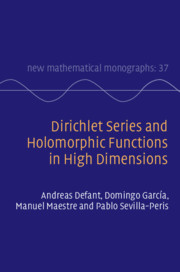Book contents
- Frontmatter
- Contents
- Introduction
- Part 1 Bohr’s Problem and Complex Analysis on Polydiscs
- 1 The Absolute Convergence Problem
- 2 Holomorphic Functions on Polydiscs
- 3 Bohr’s Vision
- 4 Solution to the Problem
- 5 The Fourier Analysis Point of View
- 6 Inequalities I
- 7 Probabilistic Tools I
- 8 Multidimensional Bohr Radii
- 9 Strips under the Microscope
- 10 Monomial Convergence of Holomorphic Functions
- 11 Hardy Spaces of Dirichlet Series
- 12 Bohr’s Problem in Hardy Spaces
- 13 Hardy Spaces and Holomorphy
- Part 2 Advanced Toolbox
- Part 3 Replacing Polydiscs by Other Balls
- Part 4 Vector-Valued Aspects
- References
- Symbol Index
- Subject Index
5 - The Fourier Analysis Point of View
from Part 1 - Bohr’s Problem and Complex Analysis on Polydiscs
Published online by Cambridge University Press: 19 July 2019
- Frontmatter
- Contents
- Introduction
- Part 1 Bohr’s Problem and Complex Analysis on Polydiscs
- 1 The Absolute Convergence Problem
- 2 Holomorphic Functions on Polydiscs
- 3 Bohr’s Vision
- 4 Solution to the Problem
- 5 The Fourier Analysis Point of View
- 6 Inequalities I
- 7 Probabilistic Tools I
- 8 Multidimensional Bohr Radii
- 9 Strips under the Microscope
- 10 Monomial Convergence of Holomorphic Functions
- 11 Hardy Spaces of Dirichlet Series
- 12 Bohr’s Problem in Hardy Spaces
- 13 Hardy Spaces and Holomorphy
- Part 2 Advanced Toolbox
- Part 3 Replacing Polydiscs by Other Balls
- Part 4 Vector-Valued Aspects
- References
- Symbol Index
- Subject Index
Summary
We work with integrable functions on the polytorus, both in finite and infinitely many variables. For such a function and a multi-index the corresponding Fourier coefficient is defined. For each 1 ≤ p ≤ ∞ the Hardy space H_p consists of those functions in L_p having non-zero Fourier coefficients only for multi-indices in the positive cone. The Hardy space H_\infty on the infinite dimensional polytorus and the space of bounded holomorphic functions on Bc0 are isometrically isomorphic. To prove this the Poisson kernel in several variables is defined, and the Poisson operator (defined through convolution with this kernel) is considered. With these it is shown that the trigonometric polynomials are dense in L_p for 1 ≤ p < ∞ and weak*-dense in L_\infty, and that so also are the analytic trigonometric polynomials in H_p and H_∞. The isometry between the two spaces is first established for the finite dimensional polytorus/polydisc and then, using a version of Hilbert’s criterion (see Chapter 2), raised to the infinite-dimensional case. The density of the polynomials can be proved using the Féjer kernel instead of the Poisson one.
Keywords
Information
- Type
- Chapter
- Information
- Dirichlet Series and Holomorphic Functions in High Dimensions , pp. 111 - 128Publisher: Cambridge University PressPrint publication year: 2019
